The Grande Galerie de l’Évolution in Paris is an attraction for anyone interested in life on Earth. Located in the heart of the Jardin des Plantes, at the Grande Galerie de l’Évolution you can explore the biological diversity of our planet. Here, you can admire numerous specimens of stuffed animals. In this article, discover what makes this museum unique and what to expect during a visit with children.
Table of Contents
About the Grande Galerie de l’Évolution in Paris
The Grande Galerie de l’Évolution in Paris is a museum dedicated to biological diversity and the evolution of living things. There is an extensive collection of stuffed animals displayed in an innovative way. Located in the Jardin des Plantes, it opened as part of the Museum National d’Histoire Naturelle in 1889 on the occasion of the Universal Exhibition. The first version of this museum was a classic, boring, natural science museum. Today, it is entirely different, with interactive experiences.
PLAN YOUR TRIP TO PARIS
Save money in Paris with the Paris City Card or the Paris Museum and Experiences Pass. Get free entry to major museums, climb the Eiffel Tower, and enjoy a Seine cruise and tourist bus.
To stay connected in France, remember to buy an Airalo eSim online, with data and phone coverage for your trip to Paris.
The First World War and the lack of heating had caused significant damage to the structure and the collection of taxidermied animals, resulting in the museum’s closure in 1966. What you visit today is a very different gallery from the original, with an innovative approach.
In 1994, architects and set designers Borja Huidobro, Paul Chemetov, and René Allio completely renovated the exhibition spaces. Their design created a unique atmosphere with theatrical effects. You can watch variations of light and hear sound according to the time of day. Today, the Grande Galerie of Evolution is a must-see attraction for anyone interested in life on Earth. It could easily compete with a nature theme park installation.
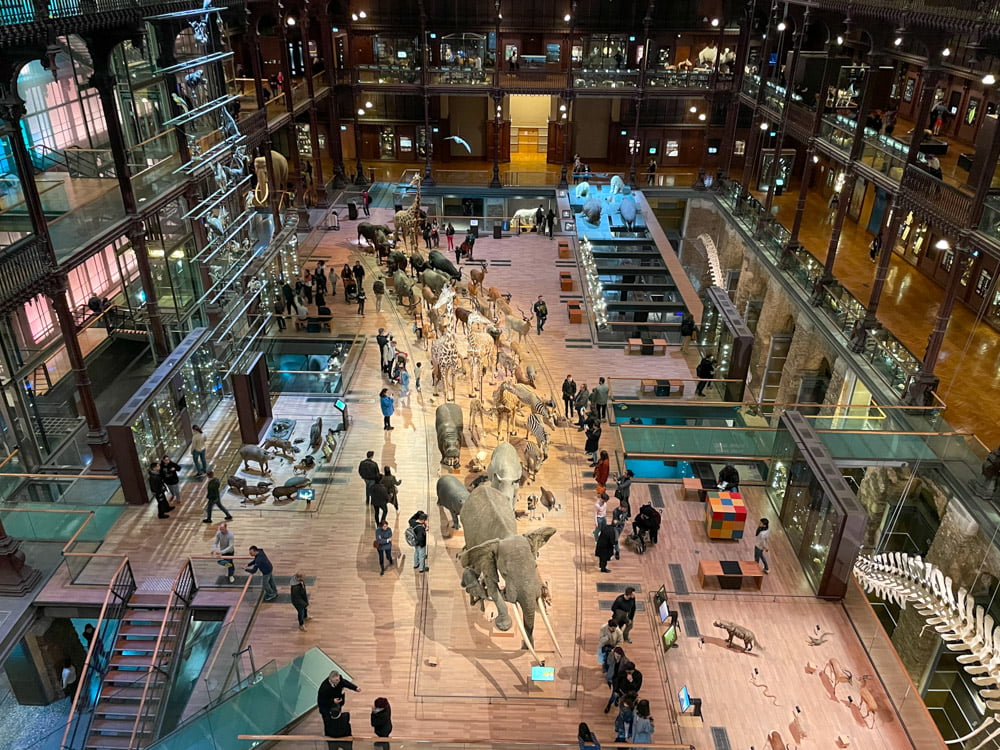
Grande Galerie de l’Evolution in Paris: what to see
The main attraction of the Grande Galerie de l’Évolution is the long row of animals on the first floor. It leaves a lasting impression on every visitor. The Great Gallery of Evolution offers a unique experience thanks to theatrical effects. There are changing light and sound effects of the animals and weather conditions such as wind and rain. Depending on the time of your visit, you can experience the jungle or the savannah at dawn or dusk.
The exhibition is spread over three floors, covering a total space of about 6,000 square metres. Each floor has a specific theme. The ground floor is about the species that inhabit the sea. The first floor is about the land’s animals, focusing on how humans can influence animal species. Lastly, the highest floor shows the evolution of life through its mechanisms.
There is so much to see in the Great Gallery of Evolution that it is impossible to linger over everything. Ideally, you should also return regularly to see the temporary exhibitions that change over time. The most curious and popular specimens among visitors are: penguins, zebras, lions, and elephants, including one attacked by a tiger.
I also really enjoyed the fish, which I had never seen stuffed. All the preserved specimens are displayed in totally natural positions. That is why the Great Gallery of Evolution is a fascinating place. It offers an educational and engaging experience for everyone, adults and children alike. It is different from the classical natural science museums!
The emperor penguin
The Great Gallery of Evolution in Paris houses a collection of stuffed penguins, including young emperor penguin specimens. These exhibits allow visitors to admire the beauty of these creatures up close and learn more about their anatomy and the characteristics of this endangered species.
The emperor penguin is the biggest member of the penguin family and a symbol of Antarctica. It is known for its ability to adapt to low temperatures. Children are generally fascinated by the fact that penguins have lost the ability to fly. Their wings, in fact, have become swimming fins. They can survive extreme climatic conditions thanks to their dense, insulating plumage.
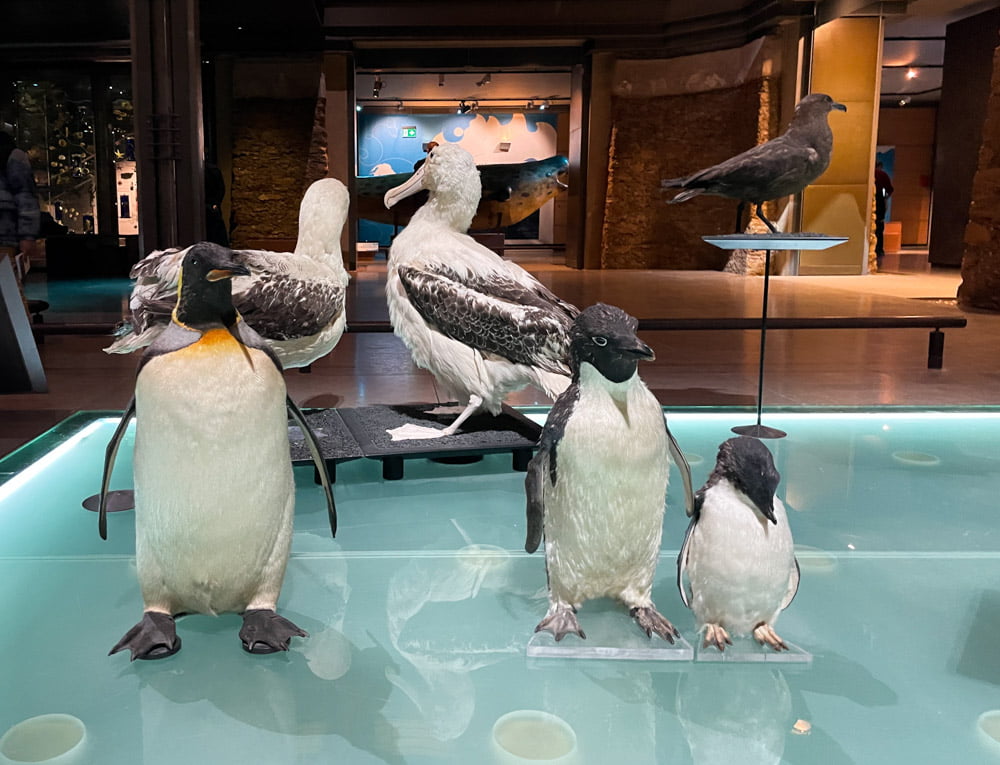
The zebra (quagga) of Louis XVI
The quagga was an animal of the zebra family. They lived in South Africa and had a brown coat with stripes only on the front of the body. The quagga was widespread and lived in large groups. Unfortunately, this species was declared extinct at the end of the 19th century due to early European settlers’ wild hunting for its skin and meat.
The Great Gallery of Evolution exhibits one of the few preserved (taxidermied) quagga that has come down to us. The museum specimen was brought to Versailles in 1784 for Louis XVI. Few years later, it was transferred to the Ménagerie du Jardin des Plantes, where it died.
The museum houses the bodies of numerous specimens of extinct or endangered animals, showing the diversity of life on Earth and man’s impact on the environment and biodiversity. The quagga of Louis XVI, in particular, reminds us of the loss of biodiversity due to indiscriminate hunting.
The Cape lion
The Great Gallery of Evolution exhibits animals to show their biodiversity and raise awareness of the negative consequences of human action on the planet, which can lead to the extinction of many species. One such example is the Cape lion, a sizeable black-maned lion belonging to the Panthera Leo Melanochaita species.
The Cape lion is now extinct because it was hunted intensively as a trophy because of its sizeable black mane that extended over its shoulders and belly. This animal was imposing, weighing up to 250 kilos and reaching three metres in length.
The last wild Cape lion would be killed in 1858. The last representative of their specie would die in captivity around 1865. The specimen exhibited in the Grande Galerie de l’Evolution, a male lion, is the only individual photographed alive. He lived in the Ménagerie of the Jardin des Plantes in 1860.
The elephants in the Grande Galerie de l’Evolution
The Grande Galerie de l’Évolution in Paris houses two elephant specimens that capture the attention of visitors. The first one is Siam, a preserved and taxidermied Asian elephant. The second one is the Duke of Orleans’ tiger and elephant group. Thanks to these specimens, visitors can see how these animals were considered and represented in the era in which they lived.
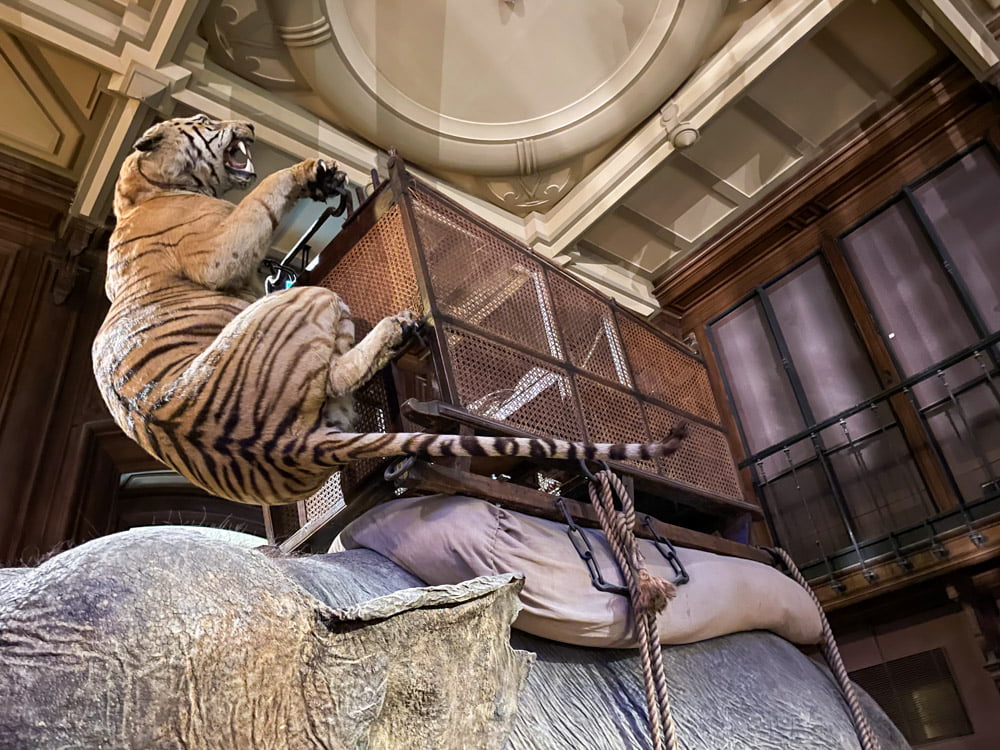
The Siam elephant
Among the animals on display at the Great Gallery of Evolution in Paris, one of the most popular with the public is undoubtedly Siam. He is the Asian elephant with its trunk sticking out of the stairwell. However, Siam is no ordinary specimen. His body was taxidermied precisely to preserve his memory.
Siam’s story symbolises a time when elephants were exploited for their labour power and ivory. Born in India in the 1940s, Siam was trained to transport logs in the forests. At the age of twelve, he was sold to the Swiss national circus Knie. He was transported through Europe to participate in travelling shows and films. However, frequent attacks on his handler, common among male elephants, forced the circus to hand Siam over to the Paris Zoo in 1964. There, he sired fourteen baby elephants and lived until he died in 1997.
Today, the Asian elephant is considered endangered. Once widespread throughout Asia, you can only find them in India and South East Asia. Unfortunately, illegal hunting and the loss of its natural habitat are threats to its survival. Siam’s body on display at the Great Gallery of Evolution in Paris reminds us of the importance of protecting this animal species, to ensure its survival, and prevent it from suffering the same fate as other already extinct species.
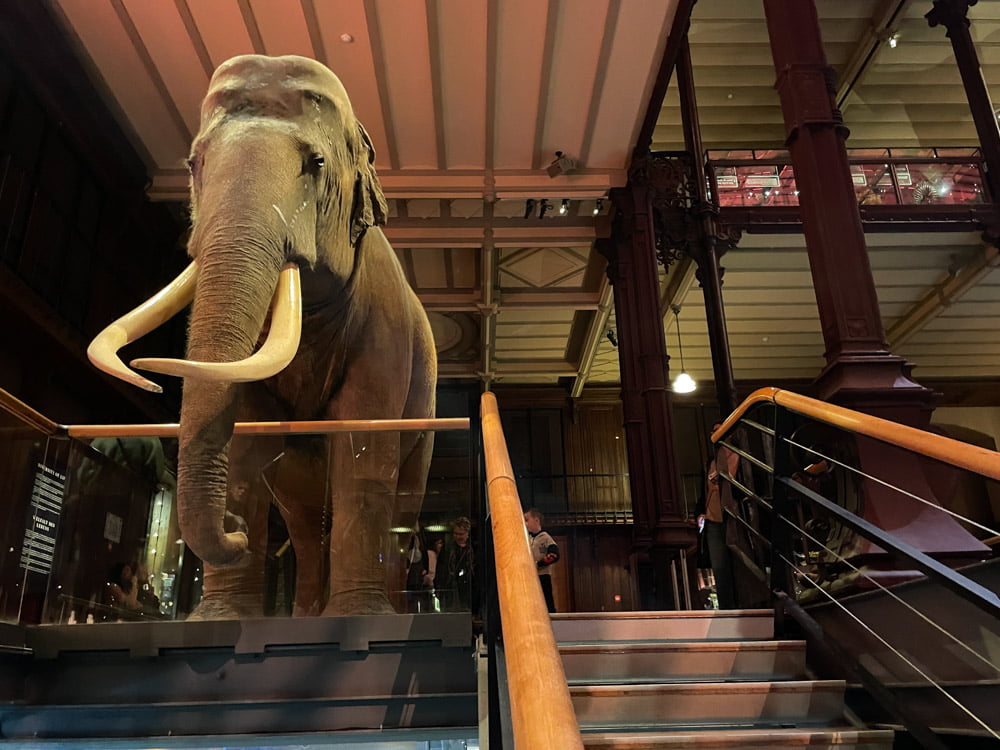
The elephant with the Duke of Orleans’ tiger
The group of elephant with a tiger of the Duke of Orleans, donated to the museum in 1926, is one of the most significant Victorian monuments of 19th-century taxidermy. It was made by a British workshop. The Duke donated this work to the museum with his collection in 1926. The elephant has the dual significance of commemorating the early explorers, who contributed to the knowledge of nature, and recalling a curious episode of tiger hunting.
During a trip to India in 1888, Philippe d’Orléans took part in a tiger hunt in Nepal, which at the time belonged to the British Indies. During the event, a tiger was defending its cubs. She attacked an elephant, clinging to the hut’s wall until it collapsed, causing it to flee. Years later, Philippe d’Orléans honoured the tiger’s courage with a commemorative and scientific sculpture.
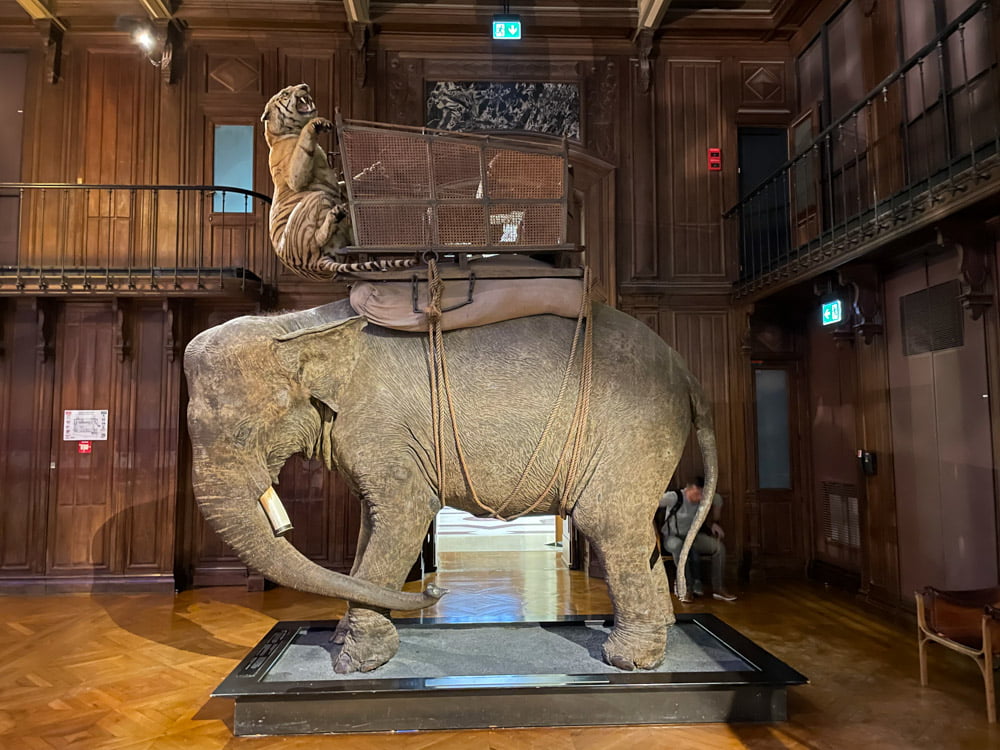
Fish at the Grande Galerie de l’Évolution
The Grande Galerie de l’Évolution in Paris houses an extensive collection of stuffed animals, including numerous fish specimens. These marine animals are displayed in a section dedicated to the biodiversity of oceans and rivers, covering different geographical and climatic areas. Walking through this section will leave you genuinely amazed at the great variety of fish species.
Among the fish in the collection are species living in the Atlantic’s temperate waters, such as cod and sole, but also brightly coloured tropical creatures such as clownfish and butterflyfish. The collection includes giant fish, such as the white shark and the bluefin tuna, caught in the open sea and then displayed in the Grande Galerie de l’Évolution.
Each specimen has been carefully and expertly prepared by the museum’s experts, using advanced embalming techniques to preserve the animal’s original appearance for a long time. Thanks to their presence in the gallery, these stuffed fish offer the public a unique opportunity to explore the marine world’s beauty and diversity and understand the importance of its conservation.
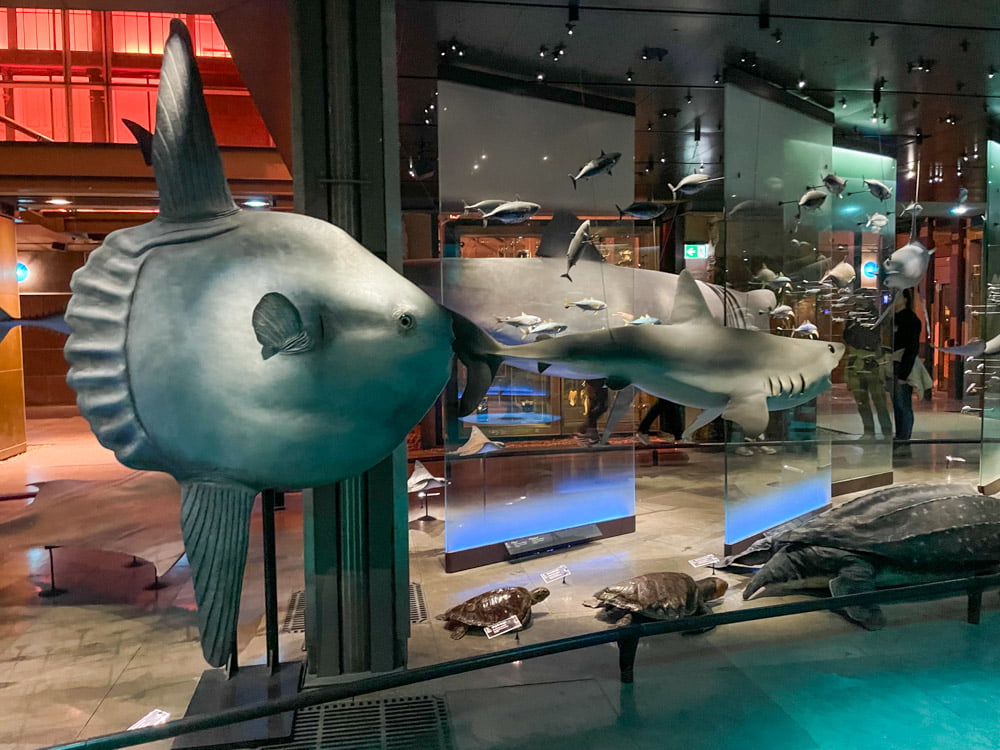
Visiting the Grande Galerie de l’Évolution with children: discovering animals
The Grande Galerie de l’Évolution in Paris is an ideal place to visit with children to discover the fauna of our planet. Here, young visitors can admire countless stuffed animals worldwide and learn about them thanks to explanatory captions and interactive stations.
Not being the first museum that comes to mind when visiting Paris, I discovered the Grande Galerie de l’Evolution, thanks to expat friends in Paris. Along the way, you can encounter all kinds of animals, but it is mainly the large mammals that attract the attention of the little ones. Also, if you speak French, the Gallery offers several activities specially designed for children, such as guided tours and interactive workshops.
I advise you not to be in a hurry and to wait for the light and sound effects of the Great Gallery of Evolution to activate. Children can notice the differences between the various natural environments and times in open spaces. Observing these changes is also very interesting for adults because it forces you to reflect on your approach to nature.
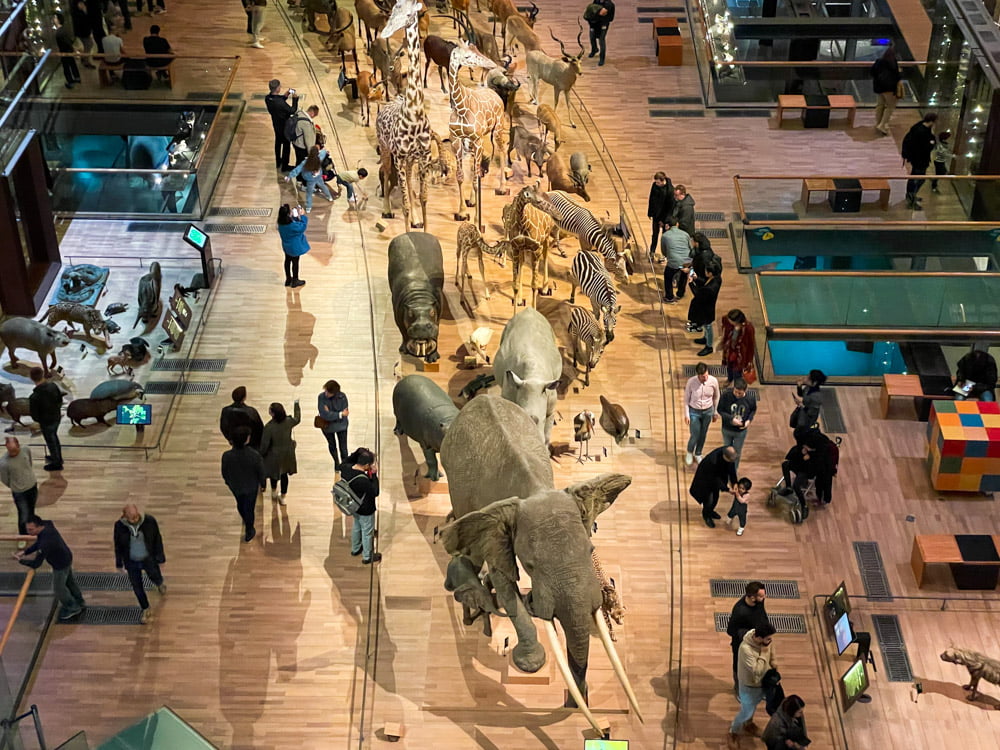
Information for visiting the Grande Galerie de l’Évolution in Paris
The Grande Galerie de l’Évolution in Paris is in the Jardin des Plantes and can be visited daily except Tuesdays. Ticket prices vary according to age and type of visit. At the time of writing, no combined ticket includes admission to other attractions of the Paris Natural History Museum, Muséum National d’Histoire Naturelle.
Opening and closing times of the Great Gallery of Evolution
The Grande Galerie de l’Évolution in Paris is open daily, except Tuesdays, from 10 am to 6 pm. The last admission to the ticket office is one hour before closing time. It is closed only on 1 January, 1 May and 25 December.
You may find queues at the entrance during school holidays and weekends because the Grande Galerie de l’Évolution is a top-rated museum among Parisian families. If you can’t visit the museum on a different day, I suggest you arrive at opening time, when there are fewer visitors.
How much tickets for the Grande Galerie de l’Évolution cost
The Grande Galerie de l’Évolution is part of the Muséum National d’Histoire Naturelle complex in Paris, which includes several museums, such as the Gallery of Palaeontology and Comparative Anatomy, the Musée de l’Homme, the Paris Zoological Park, the Jardin des Plantes and others. Some sites have free admission. Others require a separate ticket.
The ticket for the Grande Galerie de l’Évolution costs €10. You’ll find the same price online and at the ticket office or online. I recommend booking your admission in advance, especially if you want to visit at the weekend.
How to get to the Grande Galerie de l’Évolution in Paris
The Great Gallery of Evolution is inside the Jardin des Plantes, in the centre of Paris (5th arrondissement). You can easily reach the museum by metro, RER or bus. Due to its location in the centre of Parisian traffic, with few paid parking spaces nearby, I advise against travelling by car.
If you are arriving from a suburban area, the RER or metro will take you comfortably to your destination with the Gare d’Austerlitz stop just a few steps away from the Jardin des Plantes. Always check the most convenient route on Google Maps, which works great in Paris.
Grande Galerie de l’Évolution
36 Rue Geoffroy-Saint-Hilaire
75005 Paris
Where to stay in Paris
Sleeping in Paris can be expensive, prompting you to consider staying outside the city centre. In such a case, before selecting a hotel, I suggest you read my article on the best and worst neighbourhoods to stay in Paris.
I’ve visited Paris on several occasions for leisure and work, and I recommend a few places I’m familiar with. If you’re looking for a unique stay, Hôtel de Joséphine Bonaparte, built inside a 17th-century convent and located in the Marais district, is an excellent choice.
To save money, opt for the more affordable Hotel Bloum, situated close to the Opera and decorated with customised furnishings. Alternatively, the Aparthotel Adagio Paris Montmartre offers contemporary, self-catering apartments, perfect for families looking for more space in their rooms.
The Grande Galerie de l’Evolution in Paris offers an exciting and educational experience for the whole family to explore the diversity of life on Earth. Through interactive exhibits and information panels, children can learn about the evolution of fauna and flora in a fun and engaging way. Feel free to comment if you were intrigued by this article and if you would include the Grande Galerie de l’Évolution in your next trip to Paris.
